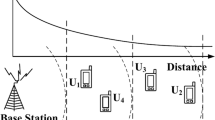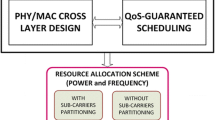Abstract
The next step in the evolution of UMTS is the Enhanced Uplink or high speed uplink packet access (HSUPA), which is designed for the efficient transport of packet switched data. We propose an analytic modeling approach for the performance evaluation of the UMTS uplink with best-effort users over the enhanced uplink and QoS-users over dedicated channels. The model considers two different scheduling disciplines for the enhanced uplink: parallel scheduling and one-by-one scheduling. Resource Management in such a system has to consider the requirements of the dedicated channel users and the enhanced uplink users on the shared resource, i.e. the cell load. We evaluate the impact of two resource management strategies, one with preemption for dedicated channels and one without, on key QoS-indicators like blocking and dropping probabilities as well as user and cell throughput.
Similar content being viewed by others
References
3GPP (2005a). TS 25.309 V6.4.0 FDD enhanced uplink; overall description (Technical report). 3GPP.
3GPP (2005b). TS 25.321 V6.6.0 Medium Access Control (MAC) protocol specification (Technical report). 3GPP.
Altman, E. (2002). Capacity of multi-service cellular networks with transmission-rate control: a queueing analysis. In Proc. of ACM MobiCom ’02 (pp. 205–214). Atlanta, Georgia, USA.
Boxma, O. J., Gabor, A. F., Núñez-Queija, R., & Tany, H.-P. (2006). Performance analysis of admission control for integrated services with minimum rate guarantees. In Proc. of NGI 2006, València, Spain.
Fenton, L. F. (1960). The sum of log-normal probability distributions in scatter transmission systems. IRE Transactions on Communication Systems, 8(1), 57–67.
Fodor, G., & Telek, M. (2005). Performance analysis of the uplink of a CDMA cell supporting elastic services. In Proc of NETWORKING 2005 (pp. 205–216). Waterloo, Canada.
Fodor, G., Telek, M., & Badia, L. (2006). On the tradeoff between blocking and dropping probabilities in CDMA networks supporting elastic services. In Proc. of networking 2006 (pp. 954–965). Coimbra, Portugal.
Holma, H., & Toskala, A. (Eds.). (2001). WCDMA for UMTS. New York: Wiley.
Hossfeld, T., Mäder, A., & Staehle, D. (Eds.). (2006). When do we need rate control for dedicated channels in UMTS? In Proc. of IEEE VTC spring ’06 (pp. 425–429). Melbourne, Australia.
Jäntti, R., & Kim, S.-L. (2001). Transmission rate scheduling for the non-real-time data in a cellular CDMA system. IEEE Communication Letters, 5(5), 200–202.
Kumaran, K., & Qian, L. (2003). Uplink scheduling in CDMA packet-data systems. In Proc. of IEEE INFOCOM ’03 (pp. 292–300). San Francisco, CA, USA.
Litjens, R., & Boucherie, R. J. (2002). Performance analysis of fair channel sharing policies in an integrated cellular voice/data network. Telecommunication Systems, 19(2), 147–186.
Litjens, R., & Boucherie, R. J. (2003). Elastic calls in an integrated services network: the greater the call size variability the better the QoS. Performance Evaluation, 52(4), 193–220.
Mäder, A., & Staehle, D. (2006). An analytical model for best-effort traffic over the UMTS enhanced uplink. In Proc. of IEEE VTC fall ’06 (pp. 1–5). Montréal, QC, Canada.
Mäder, A., & Staehle, D. (2007). Comparison of preemptive and preserving admission control for the UMTS enhanced uplink. In Proc. of 15th KiVS (pp. 201–212). Bern, Switzerland.
Parkvall, S., Peisa, J., Torsner, J., Sågfors, M., & Malm, P. (2005). WCDMA enhanced uplink—principles and basic operation. In Proc. of IEEE VTC spring ’05 (pp. 1411–1415). Stockholm, Sweden.
Staehle, D., Leibnitz, K., Heck, K., Tran-Gia, P., Schröder, B., & Weller, A. (2003). Analytic approximation of the effective bandwidth for best-effort services in UMTS networks. In Proc. of IEEE VTC spring ’03 (pp. 1153–1157). Jeju, South Korea.
Viterbi, A. M., & Viterbi, A. J. (1993). Erlang capacity of a power controlled CDMA system. IEEE Journal on Selected Areas in Communications, 11(6), 892–900.
Author information
Authors and Affiliations
Corresponding author
Rights and permissions
About this article
Cite this article
Mäder, A., Staehle, D. Radio resource management for the UMTS enhanced uplink in presence of QoS radio bearers. Ann Oper Res 170, 183–197 (2009). https://doi.org/10.1007/s10479-008-0431-1
Published:
Issue Date:
DOI: https://doi.org/10.1007/s10479-008-0431-1




